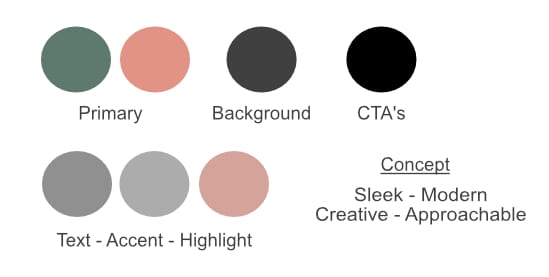A strong small business branding strategy is essential for standing out in today’s competitive market. Whether you’re launching a new venture or refreshing your look, having a clear branding strategy helps you connect with your audience through trust, memory, and being emotionally profound. So, it isn’t as simple as looking professional.
We all know first impressions matter. Your visual branding is the first impression you make, and it shapes how customers perceive your business across every touchpoint. No matter if it is your logo, website, or posts on social media, your brand identity should always reflect your values, voice, and personality. Without brand connection and consistency, your business is unlikely to reach its full growth potential.
In this post, we’ll share branding tips for small businesses and explore three core elements that define a powerful brand identity: color, typography, and messaging.
1. Branding Strategy: Color Palette
Why Color Matters
Color is one of the most powerful tools in visual branding. It evokes emotion, influences perception, and helps customers recognize your brand instantly. For small businesses, choosing the right color palette can make the difference between blending in and standing out.
How to Choose a Color Palette That Reflects Your Brand
Start by identifying the emotions you want your brand to evoke. Are you aiming for warmth and approachability? Try earthy tones or soft neutrals. Want to convey innovation and energy? Bold colors like electric blue, bright red, or a vibrant orange might be your go-to.
Your color palette strategy should include:
- Primary brand colors (used most often)
- Accent colors (used for highlights or calls to action)
- Neutral tones (used for backgrounds or balance)
Here’s a rough draft concept example of Genuinely Gina’s color palette

Color Tip: Use Color Psychology to Build Connection
Consumer studies show that up to 90% of snap judgments about products can be based on color alone. Align your color palette with your brand’s personality and audience preferences to build trust and recognition.
2. Typography: Your Small Business Branding Strategy Voice
Typography in Branding: More Than Just Fonts
Typography is the visual representation of your brand’s voice. The fonts you choose communicate tone, style, and professionalism. For small businesses, typography in branding is often overlooked, but it’s a key part of creating a cohesive brand identity.
Choosing Fonts That Match Your Brand Personality
Think of typography as your brand’s accent. A serif font might suggest tradition and reliability, while a clean sans-serif font feels modern and minimal. Script fonts can add elegance or playfulness, depending on how they’re used.
Your typography strategy should include:
- A primary font for headlines and logos
- A secondary font for body text
- Clear guidelines for font sizes and spacing
Typography Tip: Pair Fonts Strategically for Impact
Use font pairings that complement each other. For example, a bold sans-serif for headlines and a lighter serif for body copy create contrast and readability. Consistency across platforms reinforces your visual branding identity.
3. Brand Messaging—The Heart of Your Brand Story
What Is Brand Messaging, and Why It Matters?
Brand messaging is the language you use to communicate your values, mission, and personality. It’s how you connect with your audience emotionally and intellectually. Strong messaging helps small businesses build loyalty and stand out in competitive markets.
How to Craft Messaging That Resonates with Your Audience
Start with your brand’s “why.” What problem do you solve? Who do you serve? How do you make people feel? Use clear, authentic language that reflects your brand’s tone, whether it’s friendly, professional, quirky, or bold.
Your messaging strategy should include:
- A brand mission statement
- Key phrases or taglines
- Tone of voice guidelines
Messaging Tip: Align Your Messaging Across All Platforms
Consistency is key. Your website, social media, email marketing, and print materials should all reflect the same brand messaging. This builds trust and reinforces your brand identity every time someone interacts with your business.
Wrapping Things Up
Color, typography, and messaging are the foundation of a strong brand identity. When used strategically, these elements create a cohesive visual branding identity that builds trust, recognition, and emotional connection.
For small businesses in Salisbury, North Carolina, and nearby states, investing in professional branding isn’t a luxury; it’s a growth strategy. If you’re ready to elevate your brand, Genuinely Gina offers personalized branding tips for small businesses, from logo design and brand photography to full identity packages.
Let’s build a brand that’s genuinely you. Get in touch for your free consultation


